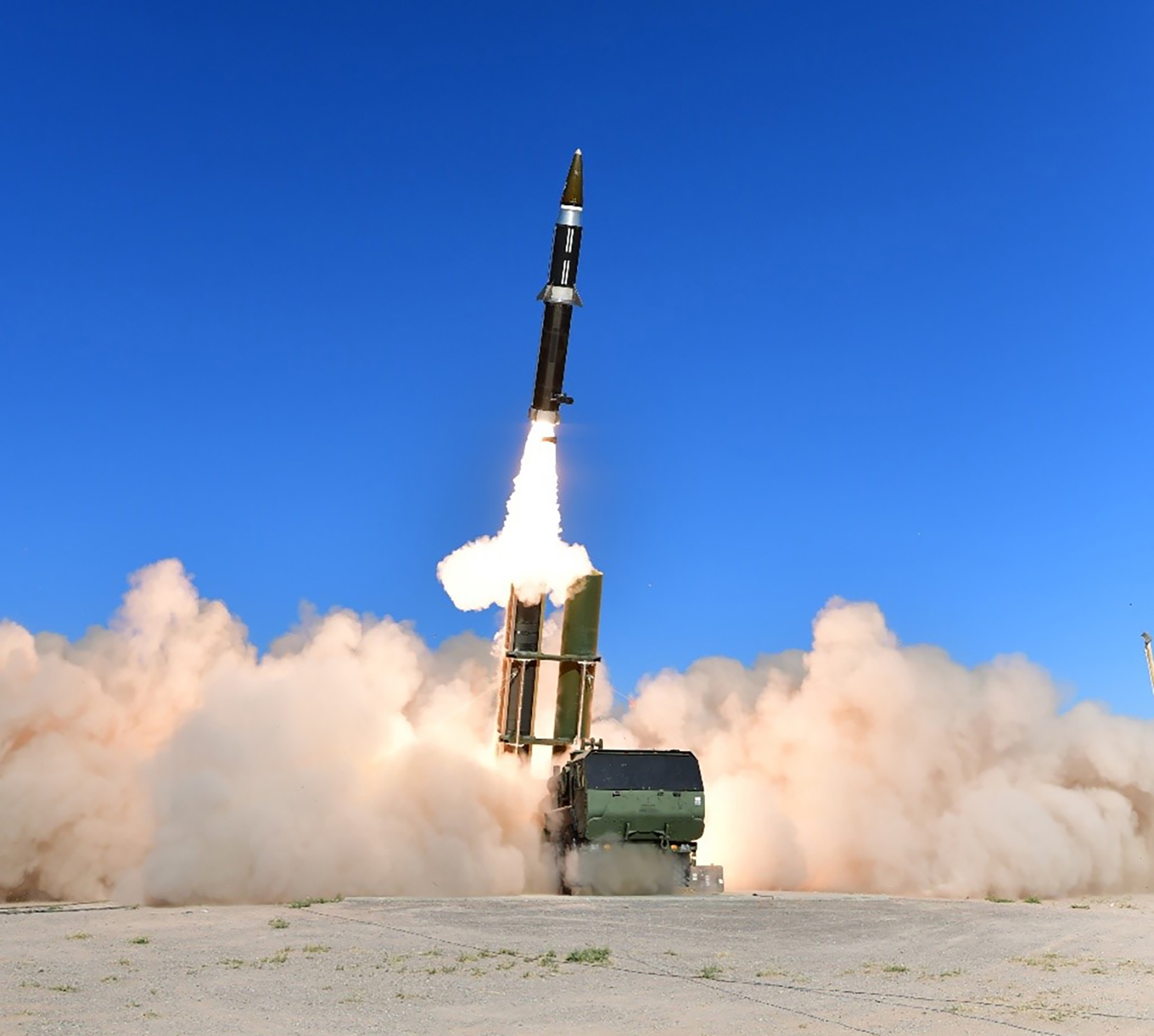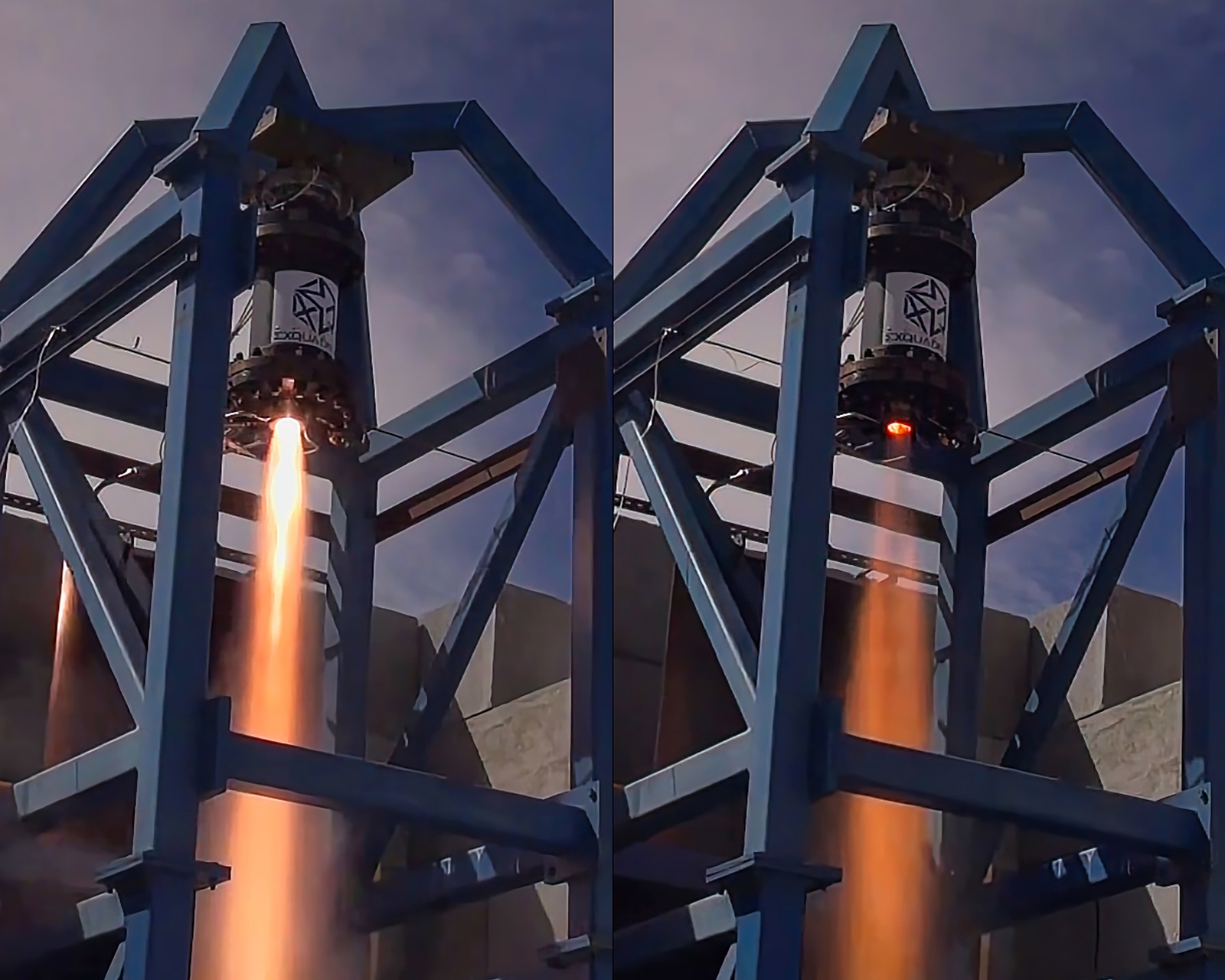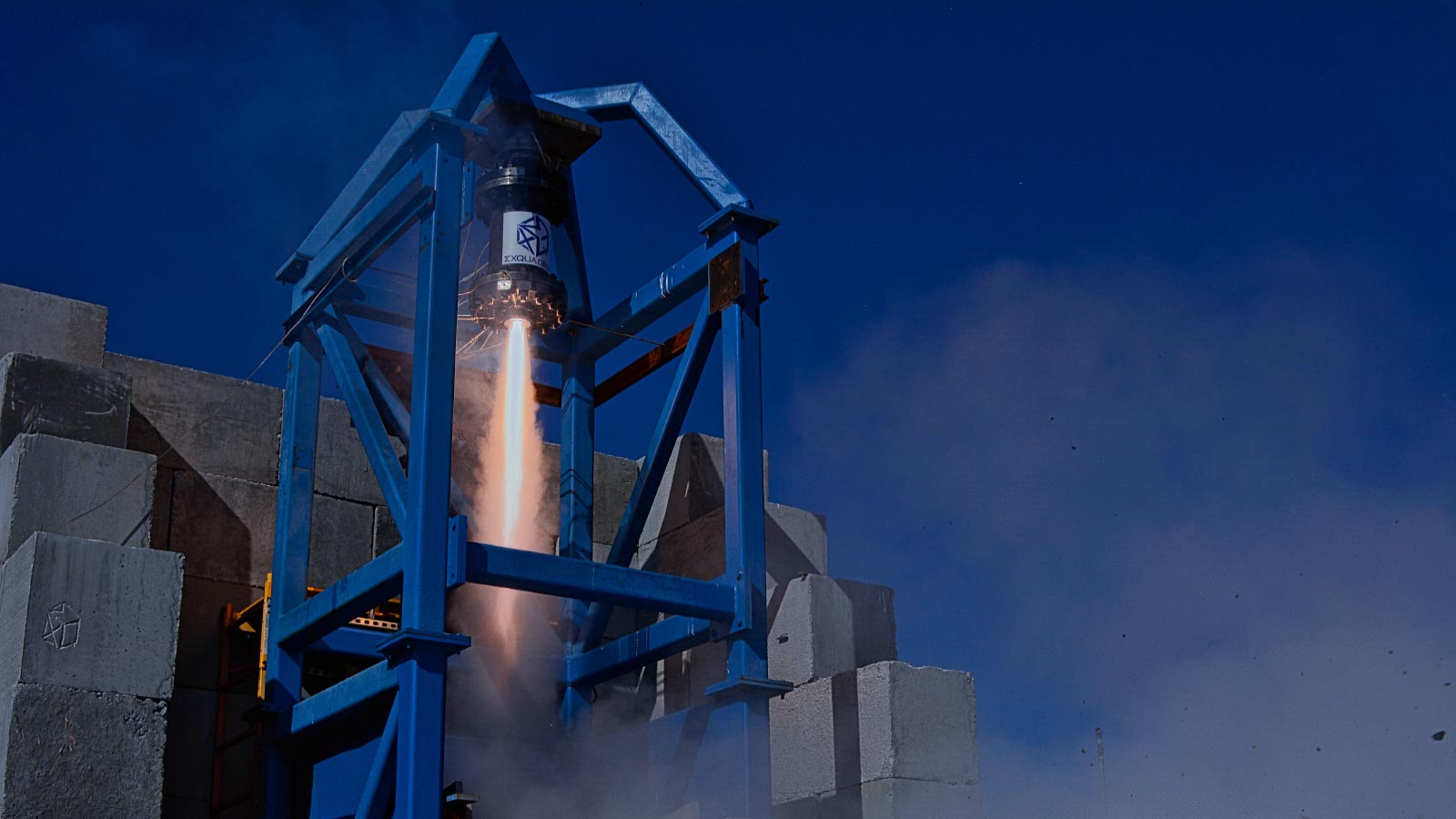Stay Up to Date
Submit your email address to receive the latest industry and Aerospace America news.
Hypersonic weapons and experimental versions share something in common: They must be boosted up to high speeds so that tests can begin or hypersonic weapons can be released. Keith Button spoke to aerospace engineers who think they have a better motor for these jobs.
Kevin Mahaffy was among those who attended a classified session six years ago at DARPA headquarters near the Pentagon to learn more about the competition for the agency’s Operational Fires program. DARPA’s goal was to empower the Pentagon to equip troops with ground-launched rockets that could loft hypersonic glide vehicles at the enemy. Mahaffy, co-founder of the small rocket company Exquadrum, came away “reeling” about the technical possibilities and says he spent the plane ride home from Washington, D.C., to California “cycling through every rocket propulsion idea that I have ever had, trying to find a solution.”
By the time the plane landed, he had scribbled notes on a cocktail napkin about an idea that he thought might work.
Exquadrum had a heritage of making solid rocket motors, each consisting of a cylinder of rubbery polymer embedded with powdered oxidizer and metals and enclosed in a case with a nozzle on the end. The solid propellant, in most designs, would burn from a hollow center outward. Normally, the entire motor would be considered the combustion chamber, Mahaffy says, but previously the company had come up with an alternative design in which the solid fuel would be cast inside a pressure vessel made of either metal or composite that would serve as the combustion chamber. A liquid monopropellant, meaning one with the oxidizer already incorporated into it, would be injected into the chamber to burn with the solid fuel. The monopropellant would augment the thrust by an amount determined by its rate of flow into the chamber. It was a strategy to overcome a downside of solid rocket motors, which is that they cannot be throttled in flight to adjust their velocity.
Exquadrum had yet to build, test or name the design. OpFires looked like a chance to get that done.
This is the story of how Exquadrum managed to win OpFires funding and how it conceived of additional hypersonics applications for the technology.
Mahaffy and Eric Schmidt started Exquadrum in 2002 after getting to know each other through 10 years as researchers at the Air Force Research Laboratory site at Edwards Air Force Base in California. After the classified DARPA session, they and their engineers considered the requirements and the idea that Mahaffy jotted down on the napkin.

The requirements were daunting in many ways, not the least of which was that DARPA wanted a missile that could be fired from a truck or a tracked vehicle. In the boost-glide application, the warhead would be accelerated to hypersonic velocity and then separate and glide to the target.
The mobile requirement ruled out a fuel that needed to be matched with liquid oxygen as the oxidizer. “Let’s say you deploy this thing and these guys are in the woods for weeks or months until they get a launch signal,” Schmidt says. “But with all this liquid oxygen that you’ve got to carry around with you, that didn’t make sense.”
Nitrous oxide, another liquid oxidizer, also wasn’t an option, mainly because of its lack of energy density compared to other propellants and its low specific impulse, a measurement of fuel efficiency.
Solids might have seemed like an obvious choice, given that missiles and nearly all hypersonic boosters in this emerging class of weapons are accelerated that way. Solid propellant remains stable and ready to fire over long periods, for 30 years in some cases. They also provide a higher energy density than any liquid or hybrid propellants.
But another DARPA requirement seemed to rule out that option: The winning design would have to be capable of unleashing small amounts of propulsion energy to hit close-in targets or large amounts of energy to hit targets at a greater distance.
To meet the DARPA range requirements, the rocket motor would need to be throttleable. It was, says Schmidt, “a very hard problem to solve.”
Mahaffy’s “aha” moment on the plane stemmed from the company’s 2017-2021 work on a liquid monopropellant for Neptune, a Missile Defense Agency program. Adding monopropellant to a solid propellant would deliver the velocities and range needed for the hypersonic missiles to hit near-in and distant targets.
One of the first tasks as they prepared their proposal was to conduct a study of fuel efficiency. This showed that the concept should indeed provide better fuel efficiency than solid-only rocket motors. They then turned Mahaffy’s cocktail napkin notes into a plan for a motor that would consist of a nozzle, a cylinder of solid fuel contained in a titanium combustion chamber and a tank for the monopropellant, the identity of which is classified. The monopropellant would be fed through tubes into the chamber, where the heat of the combustion of the solid fuel would cause a chemical reaction that releases the oxygen and fuel components of the monopropellant, resulting in it burning too. They called the conceptual motor LASR, short for Liquid Augmented Solid Rocket.
At this point, they made an unusual decision. “While we were writing the proposal, we said: ‘Well, if we’re going to write a proposal on this concept, let’s test it and see if it works,’” Schmidt says.
At their facility in Victorville, California, they attached a soda-can-sized test motor to their outdoor test bench, a meter-high steel structure. They ignited the motor and opened a valve to allow a stream of monopropellant to flow from a small tank through tubing into the combustion chamber. The result was a sharp rise in the chamber pressure and thrust. They ran a succession of tests, and the motors burned for anywhere from 1.5 to 3 seconds.
As confident as they were about throttleability, they still had to test the idea, says Elias Wilson, Exquadrum’s chief technology officer. “Can you really throttle it the way you want to, or do you saturate it in such a way that performance was down?”
Research and development is often “a game of failure” that requires many, many iterations, Schmidt says. But this time, “son of a gun, it worked like a champ the first time. That doesn’t often happen.”

Their proposal was among those selected, and Exquadrum received a 12-month contract and later a seven-month follow-on contract, worth a combined $15.1 million. The team spent the next 12 months refining the idea and testing it to measure the chemical, kinetic and thermal characteristics.
“We were able to cage and develop that concept very, very quickly,” Schmidt says.
In this refinement testing, they measured combustion rate, thrust force and other characteristics to compare various solids of different chemical formulations. They settled on a formulation that is classified, per DARPA requirements. In later iterations, they employed a solid containing an ammonium perchlorate oxidizer and powdered aluminum fuel, like the solid rocket propellant for the space shuttle’s solid rocket motors. For the liquid monopropellant, they knew from decades of industry studies that it had a high level of energy density but also a history of combusting slowly.
“We were worried that we would have issues getting it to combust,” Wilson says. But they found that the high temperature from solid fuel combustion provided the “thermal hammer” needed to chemically decompose the liquid monopropellant’s molecules for combustion.
They also spent a lot of their time working on the monopropellant injection system to pinpoint the best ratio of monopropellant to solid fuel to achieve the best combustion fuel efficiency, Wilson says: “How much monopropellant can I put in? Can I put in five or six or 20 times the amount of monopropellant?”
They measured the specific amounts of solid and liquid consumed in the scaled-down motor on the bench, as well as thrust and chamber pressure, and used those figures to calculate the performance.
They also needed to figure whether the concept would work at larger sizes. Within six months, they had proven through ground tests that a 53-centimeter-diameter motor burned as planned and for up to 30 seconds. These tests were done on a vertical, adjustable metal frame surrounded on three sides by concrete blocks, stacked LEGO style.
By month 12, they had proven their concept with an 81-centimeter-diameter motor — the full-size goal for the DARPA project. It ran for some 90 seconds, Mahaffy says. They further refined the motor over the final seven months of the contract, culminating in a ground test of a flight-ready, full-size motor. In all, they conducted some 200 hot fire tests for DARPA.
When OpFires ended in 2022, they continued developing the technology under separate programs for the Missile Defense Agency and NASA. They were pleased to learn that the monopropellant could continue combusting after the solid fuel had burned up because of the heat in the empty chamber, Wilson says.
“That was a turning point in the design,” he says. They could start the rocket motor with the solid combustion, add the monopropellant to throttle the motor up and down on top of the solid combustion, and continue to combust the monopropellant after the solid had burned up, which provided the ability to continue to throttle or turn off the motor. That opened the possibility of throttling to reach specific hypersonic velocities or to turn off propulsion at the later stage of a flight, which isn’t possible with a solid-only rocket motor.
Now, under a $2.4 million Small Business Innovation Research contract with the Missile Defense Agency, Exquadrum has started planning a 2025 flight test of the LASR motor. They haven’t decided where and when specifically they will seek to launch this sounding rocket. So far, the company has enough funding for one flight, and the hope is to raise funding from other customers for subsequent test flights.
The ultimate goal is to demonstrate a missile, meaning a rocket with guidance, and then manufacture and sell motors for tests of hypersonic materials and components. Exquadrum hopes to help the U.S. Defense Department meet its goal of 50 hypersonic tests per year to compete with China and Russia, Mahaffy says.

Exquadrum plans to market the motor as a cheaper and more precise alternative to a solid- fueled or liquid rocket. Technologists typically need to test components, engines or materials at specific Mach numbers. It just would not be affordable or practical to design, build and conduct the multiple static testing firings of a motor design that are required to qualify the design to meet a particular experiment’s required Mach number, Mahaffy says. “Typically, you’ll do at least three tests to qualify a system.”
Currently, hypersonic testers have a catalog of about a dozen different qualified solid rocket motors, and they “Frankenstein” them together, stacked in the order at which they will combust, to approximate the desired thrust profile they want for each test, Wilson says.
Researchers may want their test flights to reach specific altitudes as well, which is easier to achieve with a throttled test flight, Schmidt says. “With the solid system, you may or may not hit that just because of the variability of the solid burn out.”
David Van Wie, head of air and missile defense programs at Johns Hopkins Applied Physics Laboratory in Maryland, says if the rocket motor is affordable, “this capability could provide a useful test capability for satisfying some of the test needs for hypersonic system development.”
Depending on the testing needs, “a rocket that is throttleable provides flexibility, which could translate into more flexible test approaches,” says Van Wie, who is not associated with Exquadrum or its research.
Exquadrum says its liquid monopropellant is one-tenth the price of solid rocket fuel, which makes its rocket motor’s overall costs much lower than traditional solid-rocket test beds, Schmidt says.
“Ultimately driving cost down and either maintaining or enhancing capability — that’s what we need if we’re to move forward.”
About Keith Button
Keith has written for C4ISR Journal and Hedge Fund Alert, where he broke news of the 2007 Bear Stearns hedge fund blowup that kicked off the global credit crisis. He is based in New York.
Related Posts
Stay Up to Date
Submit your email address to receive the latest industry and Aerospace America news.




